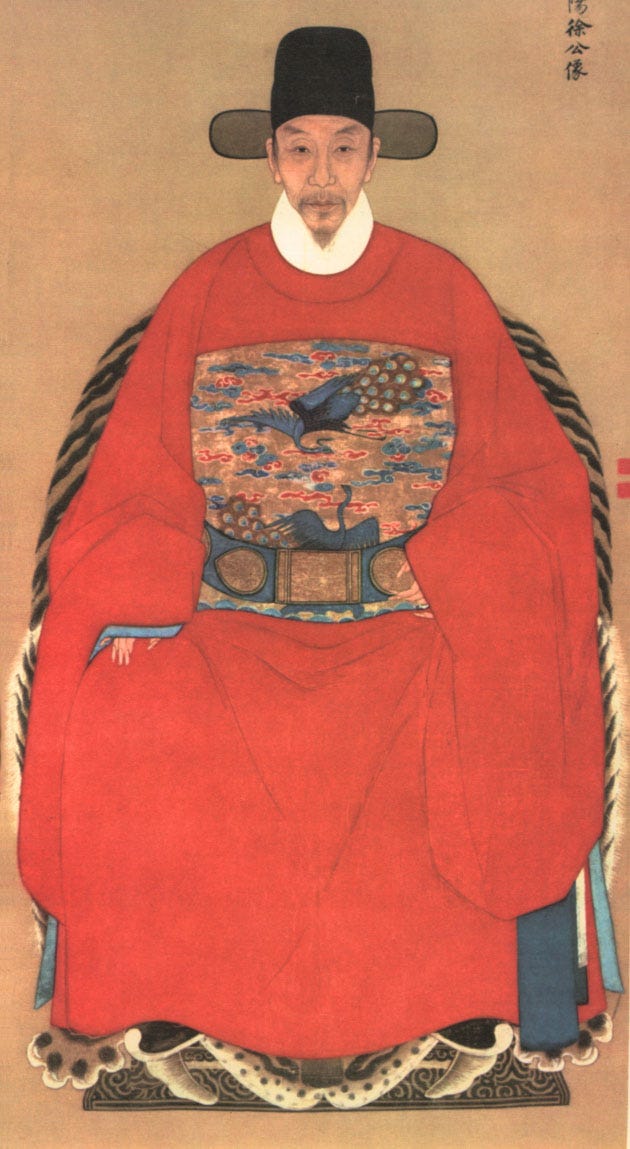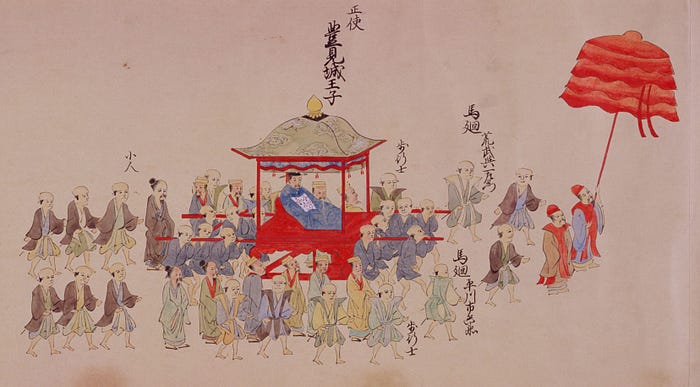Okinawans feared being forced to wear Qing dynasty costumes
Okinawa was an independent country, the Ryukyu Kingdom, until 1879.
It was conquered by the Satsuma domain of Japan in the early 17th century and was effectively a vassal state of that domain, but in form it was an independent country because it wanted to continue trade with China. At the time, China (Ming Dynasty) did not recognize formal trade with Japan, so it was necessary to keep Ryukyu as a nation.

Now, the portraits above are of two Ryukyuan crown princes. The original portraits were lost during World War II.
Shō Kyō (尚恭, 1612–1631) was the eldest son of Shō Hō (尚豊, 1590–1640), the eighth king of the second Shō dynasty. Originally, he would have been the next king after Shō Nei (尚寧, 1564–1620), the seventh king, but Shō Kyō was only nine years old (East Asian age reckoning) when Shō Nei passed away, so Shō Kyō’s father, Shō Hō, ascended to the throne. Later, Shō Kyō passed away at the age of 20 without becoming king.
Shō Jun (尚純, 1660–1707) was the eldest son of the 11th king, Shō Tei (尚貞, 1646–1709). He was a nephew of Shō Kōshin, the founder of the Motobu Udun (family). Like Shō Kyō, he was also the crown prince, but he passed away before he could become king.
Although they share the same position as crown prince, you will notice that their costumes are quite different. While Shō Kyō wears the Ming Dynasty court dress, Shō Jun wears a Ryūkyū court dress called Chōjin.

Shō Kyō wears a court dress called hofuku (補服, Chinese: bufu), with a badge of rank called hoshi (補子, Chinese: buzi) sewn on the chest. Ryukyu had been paying tribute to the Ming Dynasty since the 14th century, and the Ming emperor gave court dress as one of his gifts in return.
The cloth crown worn by Shō Kyō is also in the Ming Dynasty style. Since the Ming Dynasty gave court dress to the tributary countries, there were instances in which the court dress of those countries was adopted from that of the Ming Dynasty. The same is true of Korean court dress.

Shō Kyō was a man of the first half of the 17th century, and Shō Jun lived until the early 18th century. What happened during the time they both lived? In fact, there was a change of dynasty in China, from the Ming (1368–1644) to the Qing (1612–1912).
Since the Qing dynasty was established by Manchus, not Han Chinese, who overthrew the Ming dynasty, they abolished the previous Ming costume system and forced the Han Chinese to adopt the Manchus’ costume system.
To the Han Chinese, the Manchu are traditionally one of the barbarians. In other words, the Han Chinese were forced to wear barbarian costumes. The Chinese clothes often seen in kung fu movies are actually not traditional Chinese costumes, but Manchu costumes.
Also, the Han Chinese were forced to adopt the Manchu pigtails as their hairstyle. What would the Qing dynasty envoys think if they came to Ryukyu and saw Ryukyuan aristocrats dressed in Ming dynasty costumes? Like the Han Chinese, they might be forced to wear Manchu costumes, and their hair might be forced to be pigtailed. That was the fear of Ryukyuan aristocrats at that time.
Perhaps this fear led Ryukyuan aristocrats to stop wearing Ming court dress and crowns and start wearing their own Ryukyuan costumes and crowns before the Qing forced them to do so. This is why the court dress of Shō Kyō and Shō Jun are different.
However, Ryukyuan aristocrats did not completely abandon Ming dynasty dress. Among the envoys sent to the Tokugawa shogun, known as “Edo Nobori” (Going to Edo), the costumes of the representatives (to whom the prince was appointed) were those of the Ming dynasty.

In addition, Qing emperors began to give fabric rather than court dress as a return gift for tribute from Ryukyu. The costumes of the Ryukyuan kings began to be produced in Ryukyu using those fabrics. The court dress worn by Shō Jun, with its dragon pattern, was probably created using fabrics given to him by the Qing emperors.
Thank you for reading my story. If you would like, please follow me.

Written by Motobu Naoki
